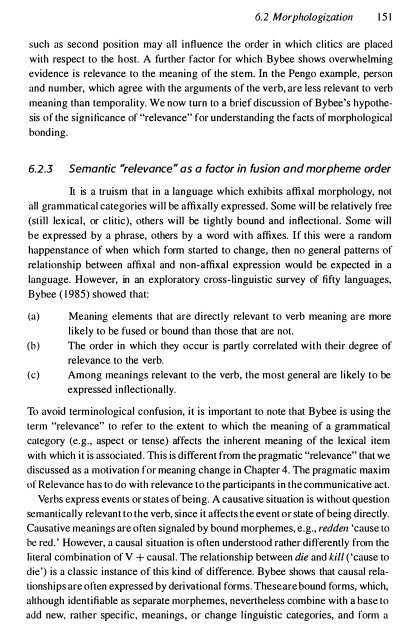Gram - SEAS
Gram - SEAS
Gram - SEAS
Create successful ePaper yourself
Turn your PDF publications into a flip-book with our unique Google optimized e-Paper software.
6. 2 Morphoiogization 151<br />
such as second position may all intluence the order in which c1itics are placed<br />
with respect to the host. A further factor for which Bybee shows overwhelming<br />
evidence is relevance to the meaning of the stem. In the Pengo example, person<br />
and number, which agree with the arguments of the verb, are less relevant to verb<br />
meaning than temporality. We now turn to a brief discussion of Bybee's hypothesis<br />
of the significance of "relevance" for understanding the facts of morphological<br />
bonding.<br />
6.2.3 Semantic "relevance " as a fador in fusion and morpheme order<br />
It is a truism that in a language which exhibits affixal morphology, not<br />
all grammatical categories will be affixally expressed. Some will be relatively free<br />
(still lexical, or c1itic), others will be tightly bound and intlectional. Some will<br />
be expressed by a phrase, others by a word with affixes. If this were a random<br />
happenstance of when which form started to change, then no general patterns of<br />
relationship between affixal and non-affixal expression would be expected in a<br />
language. However, in an exploratory cross-linguistic survey of fifty languages,<br />
Bybee (1985) showed that:<br />
(a) Meaning elements that are directly relevant to verb meaning are more<br />
likely to be fused or bound than those that are not.<br />
(b) The order in which they occur is partly correlated with their degree of<br />
relevance to the verb.<br />
(c) Among meanings relevant to the verb, the most general are likely to be<br />
expressed inflectionally.<br />
To avoid terminological confusion, it is important to note that Bybee is using the<br />
term "relevance" to refer to the extent to which the meaning of a grammatical<br />
category (e.g., aspect or tense) affects the inherent meaning of the lexical item<br />
with which it is associated. This is different from the pragmatic "relevance" that we<br />
discussed as a motivation for meaning change in Chapter 4. The pragmatic maxim<br />
of Relevance has to do with relevance to the participants in the communicative act.<br />
Verbs express events or states of being. A causative situation is without question<br />
semantically relevant to the verb, since it atfects the event or state Qfbeing directly.<br />
Causative meanings are often signaled by bound morphemes, e.g., redden 'cause to<br />
be red.' However, a causal situation is often understood rather differently from the<br />
literal combination of V + causal. The relationship between die and kill ('cause to<br />
die') is a classic instance of this kind of difference. Bybee shows that causal relationships<br />
are often expressed by derivational forms. These are bound forms, which,<br />
although identifiable as separate morphemes, nevertheless combine with a base to<br />
add new, rather specific, meanings, or change linguistic categories, and form a
















